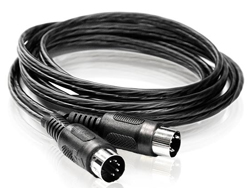MIDI is, to some, a great complicated mystery that they may never wrap their minds around completely.
However, when understood even in the most basic sense, MIDI can be harnessed and used to make the impossible possible.
I’ve designed this article to basically get you in touch with the basic concepts of the MIDI universe.
First, MIDI is an acronym which stands for Musical Instrument Digital Interface.
It is a digital information protocol developed in 1983. Being a digital information protocol it basically means that MIDI is only 1s and 0s. It is a language that allows communication between musical instruments and related devices that are MIDI capable (sequencers, computers, sound modules, samplers, etc.)
MIDI contains NO actual audio information. It is a digital communication protocol which contains only numerical commands.
Initially, many companies became interested in MIDI and its promises of grandeur, but this in turn created problems, which were remedied through the introduction of General MIDI.
General MIDI
General MIDI is a STANDARD protocol that was implemented in 1993. It is a set of specifications created for the soul purpose of easy communication between all MIDI equipment, regardless of the maker. You might think of it as a sort of universal language of electronic devices.
MIDI Signal
These are the basics of a MIDI signal:
Note ON – Tells the device when it should begin the note.
Note Number – Indicates the note which should be played. (Each and every note that can be played by musical instruments has an assigned number)
Note Velocity – Determines the acoustic intensity or volume of the note to be played. This can be a value anywhere from 0 to 127—0 being the quietest and 127 being the loudest.
Note OFF – Indicates that the note should stop being played.
This is not the only information included in the signal, but the most important. Additional Information contained in a MIDI signal includes timing information, pitch bend, program changes, channel aftertouch, polyphonic key pressure, sustain pedal, running status, etc.
MIDI Channels
A MIDI channel is basically used to send each individual part of your MIDI composition to its own individual place in your MIDI network. Without MIDI channels you could write a whole orchestral arrangement and have it placed through one single MIDI module with a piano patch loaded into its memory. To say the least, this would not be pretty.
Channel 10 will always be a percussion track. And, MIDI is capable of 16 channels.
MIDI Modes
MIDI modes are the different modes in which a MIDI device may operate. They include:
(MODE 1) OMNI ON – POLYPHONY
(MODE 2) OMNI ON – MONO
(MODE 3) OMNI OFF – POLYPHONY
(MODE 4) OMNI OFF – MONO
What does that mean? When in OMNI ON mode, the MIDI device allows the unit to respond to all incoming data regardless of its channel. When in OMNI OFF mode, the MIDI device will respond to incoming data on only one specified channel.
When POLYPHONY is engaged, the MIDI device will allow multiple notes to sound at the same time.When Mono is engaged, The MIDI device will allow only ONE note to sound at a time.
MIDI Ports
What are they and what do they do?
MIDI IN – Allows for the input of MIDI data; in other words, it is the RECEIVING port.
MIDI OUT – Allows for the output of MIDI data; in other words, it is the SENDING port.
MIDI THRU – This one’s different. Simply put, it DUPLICATES the MIDI data going into the MIDI IN port and sends it out.
Jon Tidey is a Producer/Engineer who runs his own studio, EPIC Sounds, and enjoys writing about audio on his blog AudioGeekZine.com. To comment or ask questions about this article go here.





















